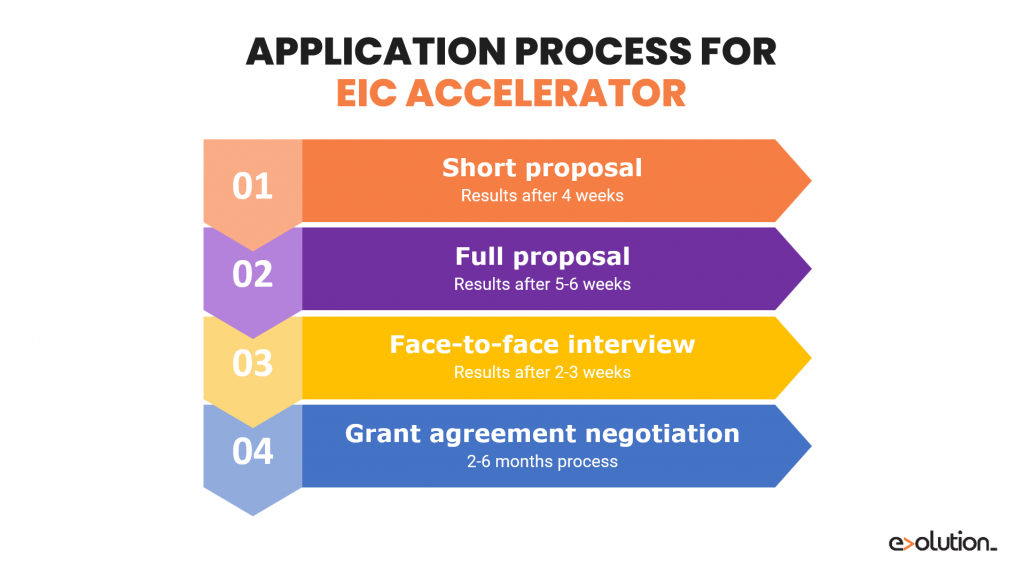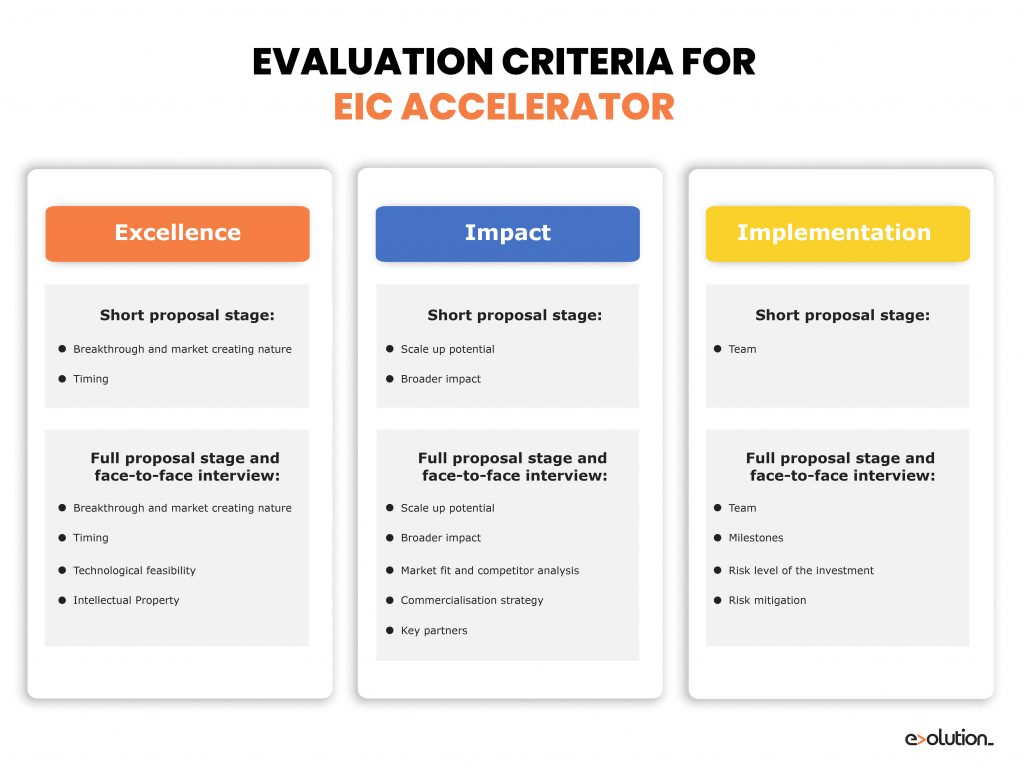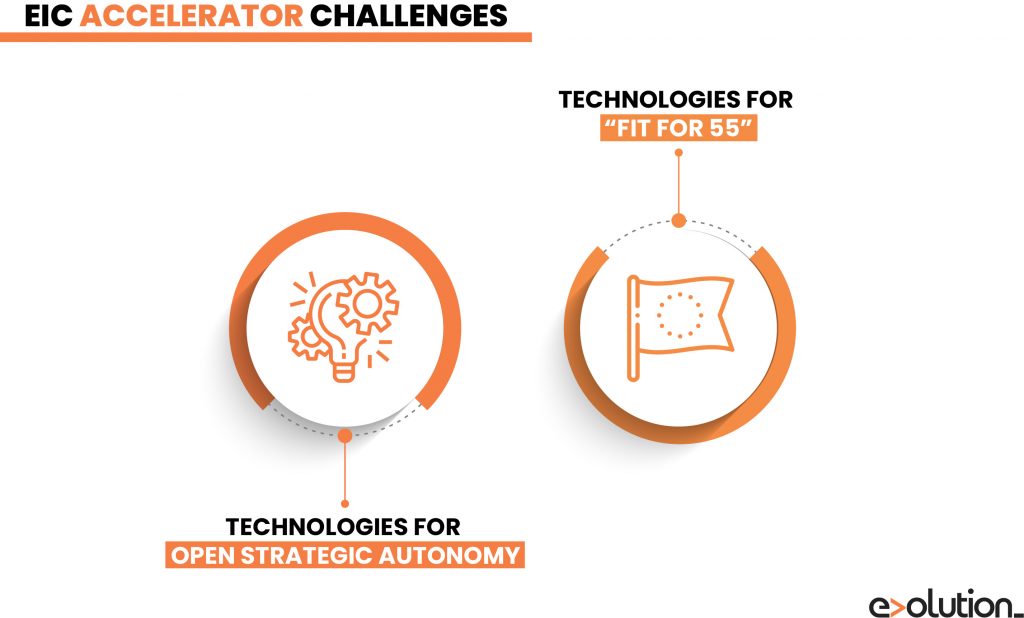FAQ: EIC Accelerator – Could I get this funding option for my project?

The EIC Accelerator represents a noteworthy option when looking for funding for our R&D start-ups and SMEs. But why is it usually like this? And why can 2022 be an excellent time to apply?
We bring you a new article from our EIC FAQ Series to spell out the main concepts about EIC Accelerator under its two different schemes: Open and Challenges.
We invite you to consider the issues below to check if the EIC Accelerator funding line could make your project grow!
EIC Accelerator
Why is the EIC Accelerator so important?
EIC Accelerator focuses on high-impact products, services or business models to develop new markets or transform existing ones. In this way, these innovations should correspond to projects on Technology Readiness Levels (TRLs) 5-6 to 9.
What is the most suitable funding modality for your project?
This programme contemplates support in two different ways:
- A grant component to reimburse costs for innovation activities from TRL 5-6 to 8 (market take-up). This option is able to cover up to 70% of eligible costs with a maximum of €2.5M. It is, in turn, divided into two modalities:
- Grant Only: If you request only this component.
- Grant First: If you don’t apply for the investment component in an initial stage but rather request a follow-up on the equity component subject to a milestone assessment later.
- Grant Only: If you request only this component.
- An investment component from the EIC Fund up to €15M (or more in duly justified cases) in the form of equity or quasi-equity (convertible loans), which is perfect for reaching TRL 9 (a rapid scale-up). Applicants for EIC blended finance can also choose this option without requesting any grant.
Due to budget restrictions, some applicants meeting all the criteria may not receive EIC funding. Still, they will be awarded a Seal of Excellence, getting access to Business Acceleration Services and facilitating obtaining funds from other sources.
Who can apply?
EIC Accelerator is conceived to support those projects that come from single applicants meeting one of the following requirements:
- A single SME established within a Member State or Associated Country.
- A single small mid-cap (up to 499 employees) from a Member State or Associated Country. If applying under this option, please notice that your project should be ready for a rapid scale-up (TRL 9) and can only apply for the investment component.
Even the single SME application is the most common form to apply, EIC Accelerator also comprises one or more natural persons or legal entities to request this programme if meeting one of the following conditions:
- They are from a Member State or an Associated Country and intend to establish an SME or small mid-cap in one of the Member States or Associated Countries.
- They submit a proposal on behalf of an SME or small mid-cap in a Member State or an Associated Country they intend to invest in.
- They are from a non-associated third country and intend to establish or relocate an SME to a Member State or an Associated Country.
Concerning the appropriate areas for EIC Accelerator, all technological fields can find their place under the EIC Accelerator Open modality as long as they count on a validated prototype and have an accurate market projection.
How does the application process work?
It takes four steps to apply to the EIC Accelerator:
1. Short proposal: It is possible to submit your application at any time through the European Funding & Tender Opportunities Portal. Four EIC evaluators will consider your five-page form, ten slides pitch deck, and your three minutes video. EIC experts will evaluate your short application checking out some issues like the breakthrough and market-creating nature, scale-up potential, impact and your team.
After 4 weeks, you will know the jury’s verdict, being necessary to get a “GO” from two or more evaluators to move to the next stage.
2. Full proposal: If your short application was successful, you should submit your project using the EIC AI-based platform to one of the cut-off dates within the next twelve months. This full application involves a complete business plan about your company’s finance and structure. Three EIC jury members will study your proposal in detail, and only if all of them consider it successful, you will be invited to the next step.
If your proposal is rejected one time, it is possible to submit it again directly to one of the following cut-offs. However, if you have been rejected twice, you won’t be allowed to resubmit your project for 12 months. For this reason, receiving accurate and professional advice is key to better performance and a higher probability of success.
3. Face to face interview: After 5-6 weeks, if your full proposal is successful, you will receive an invitation to a face-to-face interview with up to 6 jury members.
They will evaluate your pitch to decide whether your project is recommended for funding or not. In this second scenario, they can give you the opportunity to resubmit a revised proposal in another interview (only once) or to receive a Seal of Excellence that entails access to Business Acceleration Services and alternative funding sources.
4. Grant agreement negotiation: If, after 2-3 weeks, you receive the news that your interview was successful, you will be invited to negotiate an initial contract for the grant.
For proposals getting the investment component, the negotiation process between the company and the EIC Fund will start to structure the potential investment agreement. The due diligence process will take place together with some compliance checks, the definition of tranches of investment and related objectives, the search for potential co-investors, etc.

What are the evaluation criteria?
It is worth mentioning that the EIC Accelerator is a highly competitive programme in which only the most innovative deep-tech start-ups succeed. For that reason, you should know what are the key points the jury will evaluate before taking this journey:
- Excellence: During short and full stages, applicants should prove their breakthrough and market-creating nature and their right timing in terms of commercialisation. Full applications and face-to-face interviews will be also considered to demonstrate their technological feasibility and Intellectual Property Rights.
- Impact: Issues such as scale-up potential and broader impact are reviewed during short and full application and even at the face-to-face interview stage. Market fit, competitor analysis, commercialisation strategy and counting on the key partners will be taken into account only during full application and interview steps.
- Level of risk, implementation, and need for Union support: Team capability will be considered for short and full applications. Other issues such as milestones, the risk level of the investment and mitigation measures will be evaluated during full applications and interviews only.

What about EIC Accelerator’s deadlines?
As we have previously said, you can submit your short application continuously during 2022. However, full applications do have specific cut-off days. The following deadlines will be on June 15th and October 5th.
EIC Accelerator Open
What is the budget for EIC Accelerator Open?
The allocated budget for EIC Accelerator Open is around €630.96 million. From this amount, almost a quarter part (€145.5 million) will be funded through the NextGenerationEU plan as this call contributes to achieving a more resilient and sustainable Europe.
Taking into account last year’s budget was €592.5 million, the available funds increased by 6.49%, which makes us think 2022 can be a good year for participating in the programme.
What topics are welcome under the EIC Accelerator Open scheme?
This programme hasn’t predefined topic priorities as it is open to any field of technology and innovation.
EIC Accelerator Challenges
What is the budget allocated to EIC Accelerator Challenges?
This year, the total budget for the Challenges modality under the EIC Accelerator is around €536.88 million. Almost half of the amount (€250.82 million) will come from the NextGenerationEU plan, as the objectives of this programme are totally aligned with those of this EU recovery instrument.
As happens with the budget of the EIC Accelerator Open, it has been increased, in this case by 8,03%, compared to the previous year.
What are the EIC Accelerator Challenges?
The EIC Accelerator Challenges scheme looks for proposals that aim to generate significant impacts on:
- Technologies for Open Strategic Autonomy:
EIC seeks to achieve an autonomous and leader Europe able to create new technologies, pioneering solutions and disruptive innovations. They pursue the goal of strengthening European competitiveness, security and, at the end of the day, open strategic autonomy.
Some examples that may find their place under this challenge are:
-
- Components for the pharmaceutical industry.
- Strategic healthcare technologies.
- Sustainable and innovative approaches to critical raw materials.
- New applications of quantum technologies.
- Edge computing applications.
- Innovative applications making use of data and signals from EU space infrastructures.
- Development of space technologies.
- Critical security technologies.
- Technologies for innovative financial and payment infrastructures and services.
-
- Technologies for “Fit for 55”:
EIC wants to support projects that meet the “Fit for 55” proposals to achieve a sustainable and greener Europe. This Challenge will be the perfect funding opportunity for proposals able to find solutions related to:
-
-
- Higher clean energy conversion and use.
- Decarbonisation of hard-to-abate industries.
- Energy efficiency and safety in the built environment.
- Zero-emission mobility solutions.
- Climate neutrality in the land use.
- Water, gas and indoor air management/monitoring systems.
- Green digital technologies.
-


